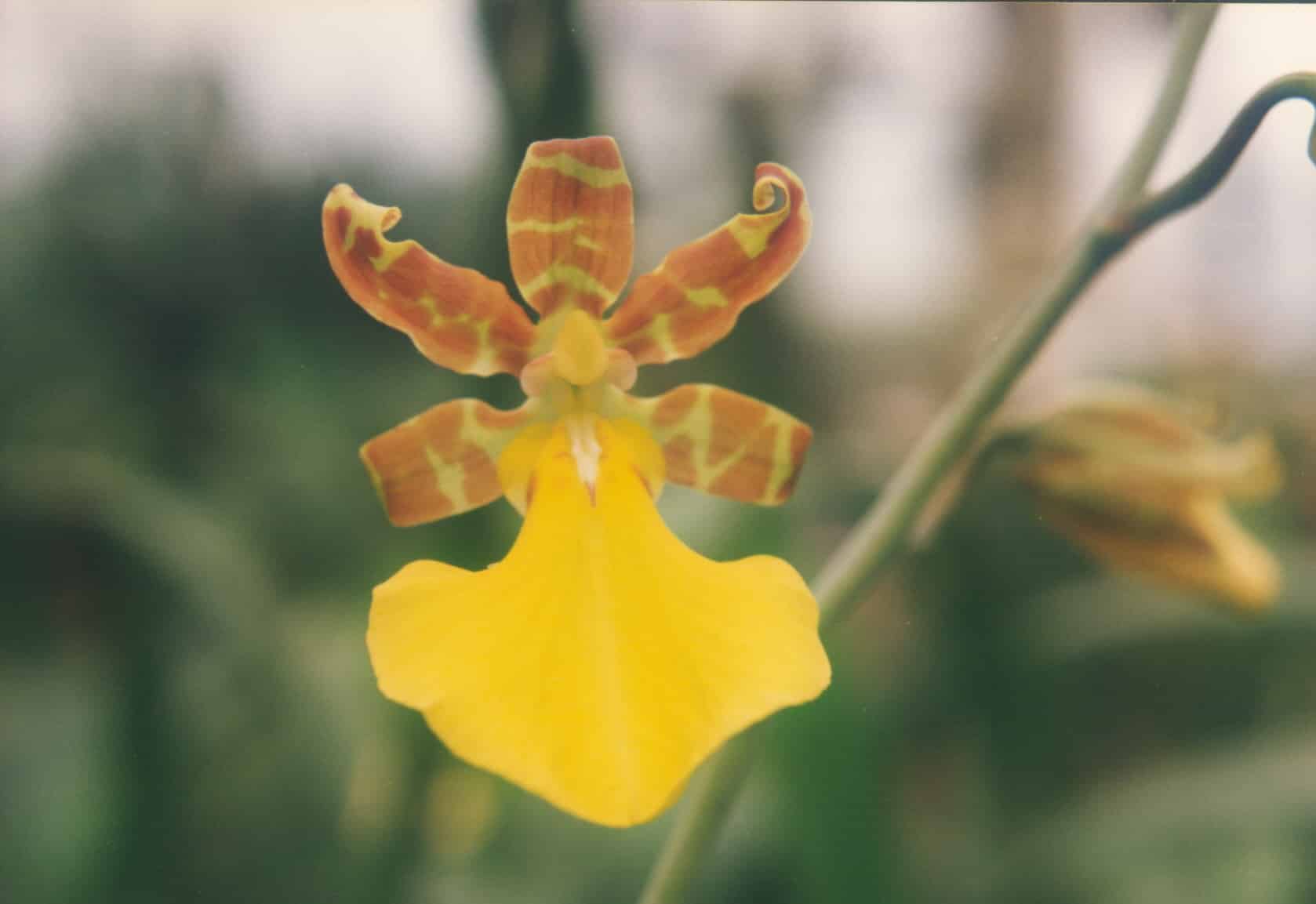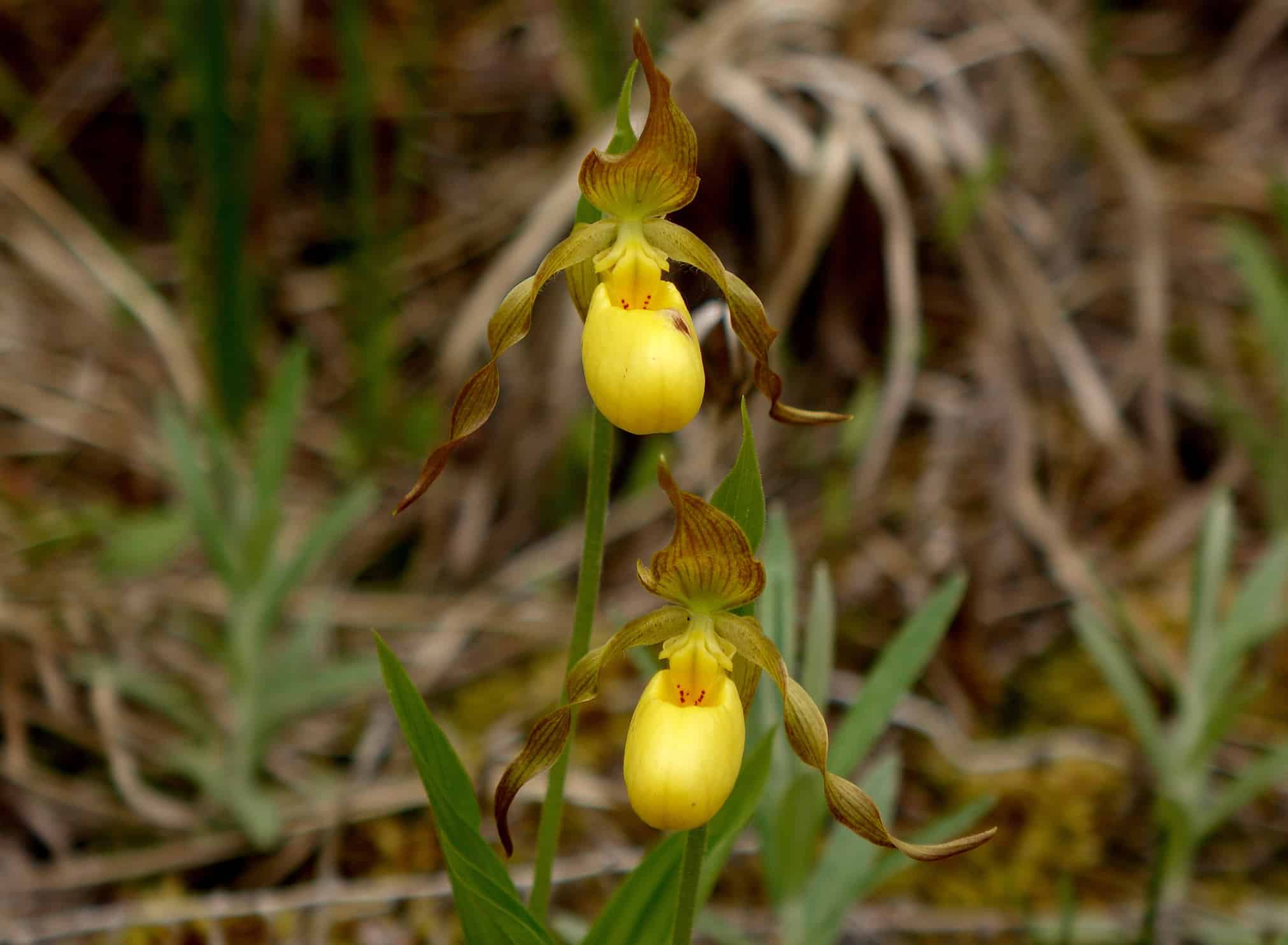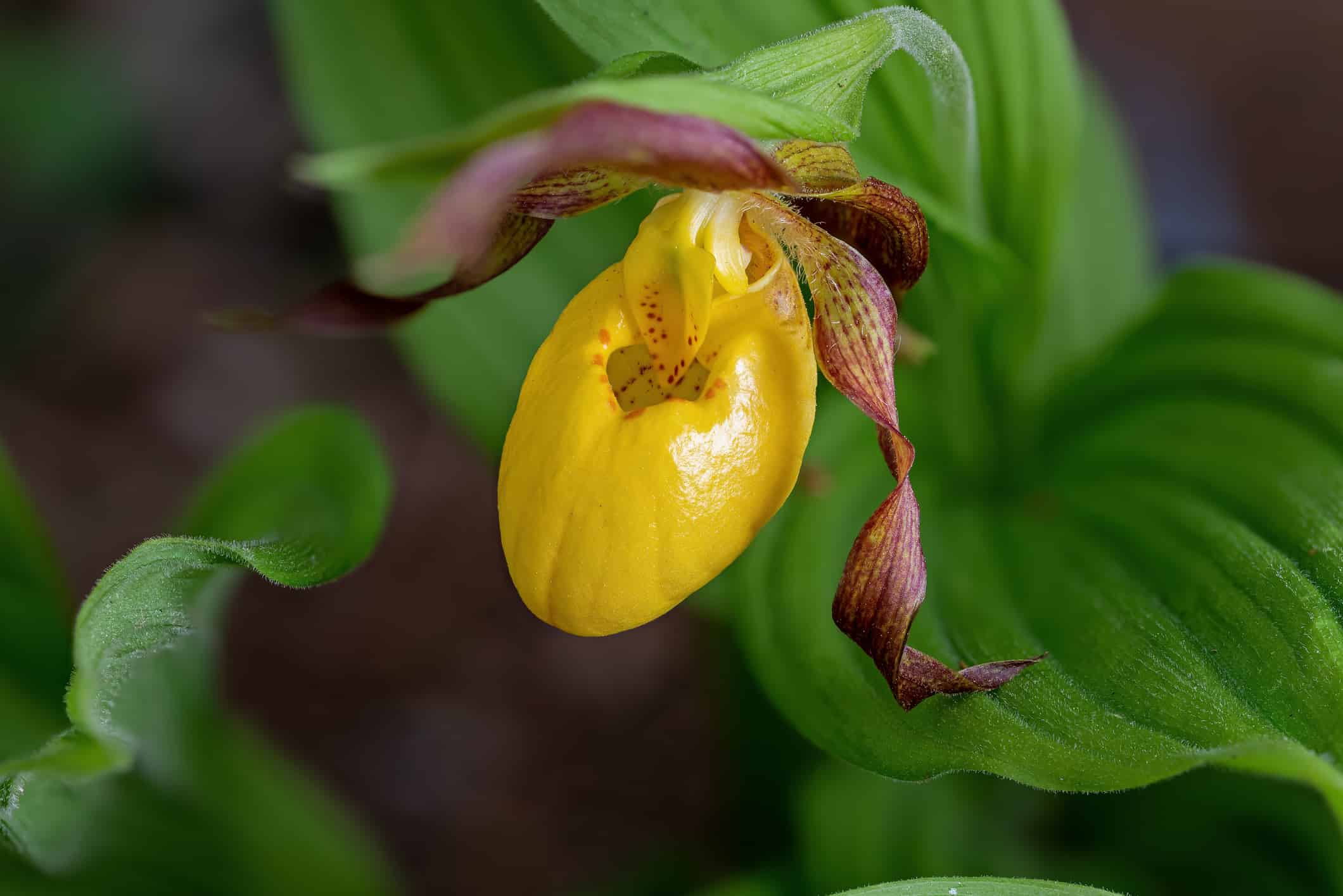If you’re interested in growing yellow orchids, you’ll be delighted to know that you have several stunning options. Yellow orchids are represented by terrestrial and epiphytic orchids that grow in various climates and habitats. So, in short, you should be able to find a species or cultivar that suits your region’s growing climate.
This guide briefly covers the diverse, complex world of orchids and reveals three of our favorite yellow orchid species. We’ll describe their native growing environment, morphology, and plant care tips.
So, let’s get to it!
Orchids: Plant Classification
Containing 850 genera and almost 30,000 species, the Orchidaceae (orchid) family currently represents the world’s second-largest plant family. Its incredible diversity has resulted in its natural spread across the Earth, natively growing on every continent except Antarctica. The diversity of orchids includes an immense range of flower colors and sizes, petal and labellum shapes, fragrances, leaf shapes and variegation, and growing habitats.
Yellow Orchids: 3 Stunning Species
Brightening both indoor and outdoor garden spaces, yellow orchids provide spaces with warmth and gentle beauty. Below we’ve listed three stunning species, describe their natural growing environments, and provide plant care tips.
1. Pale Yellow Cattleya (Cattleya luteola)

is a tropical orchid that produces fragile, pale-yellow flowers.
Belonging to the tropical genus, Cattleya, native to Central and South America, the pale yellow cattleya is an epiphyte that thrives in the heat and humidity of its native home in the Amazon rainforest. Cattleya luteola is one of about 120 species in this genus native to tropical America. Many consider cattleyas to be the classic, most represented example of orchids.
Cattleyas are divided into large-flowered unifoliate, small-flowered unifoliate, and bifoliate. Unifoliate describes orchids with one pseudobulb, a water and nutrient storage structure found at the base of the plant leaf. Bifoliate orchids have two to four leaves per pseudobulb. Cattleya luteola is the smallest of the small-flowered unifoliate and is often considered a miniature orchid.
Morphology
As its common name suggests, this tropical orchid features fragile, pale-yellow flowers that gently warm up a space with their gentle beauty. The flowers on this miniature orchid are often less than 2 inches across. The petals and sepals of this species are elongated with pointy tips. The vase-shaped column distinctly protrudes from the center of the flower, with white bordering the ruffled, cupped opening of the column. Luckily for growers of this gorgeous little plant, the multiple bursts of flowering for the pale yellow cattleya last from spring through fall.
As a small-flowered unifoliate orchid, Cattleya luteola has one leaf per pseudobulb. The pseudobulbs of this species typically reach about 2 inches tall. Leaves tend to stay at or under 6 inches and are generally moderately broad, elongated and rounded at the tip.
Plant Care
While this lovely little orchid isn’t entirely beginner-friendly, it is perhaps the most adaptable and hardy of the Cattleya species. Its temperature range and humidity tolerance are wider than that of other cattleyas, allowing it to survive cultivation in European collections of the mid-1800s. During this time period, Europe became known as the “grave of tropical orchids” as the common instruction of the time was to treat all tropical orchids, such as the unfortunate cattleyas, with high temperatures and low light. Likely this knowledge stemmed from a surface-level understanding of these orchids’ native rainforest habitat.
Thankfully for our mini orchid, Cattleya luteola fared far better than its relatives due to its adaptable nature. That being said, the pale yellow cattleya still needs specific, informed care in order to thrive and bloom.
Watering
This little orchid loves frequent moisture as an epiphyte, but the roots need to fully dry out and receive proper airflow between watering. If you live in a particularly arid region, you may need to water every other day by submerging the roots for about 20 minutes. For more humid climates, you may find that watering 2-3 times per week is sufficient. Just make sure this orchid is growing in a well-draining, aerated medium and that the roots and growing medium are fully dry between soakings.
Growing Medium and Fertilizer
A preferred mix for this species is sphagnum moss or a peat-based mix with charcoal or lava rock additives. If growing in a pot, clay with drainage holes is a great choice due to its porous, water-wicking properties. Fertilize weekly with standard orchard fertilizer at 1/4 dose strength.
Temperature and Humidity
Ideally, provide humidity levels of 70-80% and temperatures between 60-85 degrees Fahrenheit. It prefers night temperatures at the lower end of this temperature range.
Light
While Cattleya luteola can tolerate 60-70% shade, it needs brighter light conditions to bloom. You’ll want to provide bright, indirect light in its growing seasons. Some growers will place this orchid in direct sunlight for a couple of hours a day, but any more exposure tends to result in leaf burn.
2. Tiger Orchid (Trichocentrum splendidum)

produces flowers with a bright yellow labellum, yellow petals and sepals striped-mottled with deep red to brown.
©Arne and Bent Larsen or A./B. Larsen, CC BY-SA 2.5 DK via Wikimedia Commons – Original / License
Native to mid-altitude regions of Central America, the tiger orchid can grow as an epiphyte or lithophyte. Its native growing climate features humid, rainy summers and dry winters. Successful cultivation mimics this climate’s cycles. Formally situated within the genus Oncidium, and then Lophiaris, this delightful orchid now belongs to the Trichocentrum genus.
Morphology
Orchids belonging to the Trichocentrum genus are often called mule-eared orchids due to their elongated, oblong leaves that resemble the ears of a mule. Like its Trichocentrum relatives, tiger orchid leaves can grow up to 24 inches long and present as rigid, fleshy, elongated, and oval. As a unifoliate, this orchid has one leaf per pseudobulb.
The flowers of the tiger orchid are spectacular with their protruding, bright yellow labellum contrasting with yellow petals and sepals striped-mottled with deep red to brown. A fleshy, grey, multi-branched stem up to two feet high produces dense clusters of 4-inch wide flowers. In its native and similar habitats, the flowering season for tiger orchid typically lasts about three weeks in the early spring to early summer.
Plant Care
Generally regarded as fairly easy to grow and adaptable, these gorgeous orchids are a great candidate for those looking to break into the often complex world of orchid growing.
Watering
To mimic its natural growing habitat, you’ll want to water frequently in the summer and cut back on watering in the winter. While your watering schedule will depend on the humidity levels of the area, you’ll generally want to shoot for watering your tiger orchid once per week in the summer and about once every two weeks in the winter if you reduce temperatures enough (55-65 degrees Fahrenheit) for your orchid to enter a dormant period. This is ideal since most orchids need to enter dormancy in order to flower.
Growing Medium and Fertilizing
In its growing season, apply a weekly balanced orchid fertilizer when you water your plant. Just make sure to only use about 1/4 the dosage strength. A good way to remember this fertilizing schedule for orchids during the growing season is the common refrain, “fertilize weakly weekly”. The tiger orchid fares excellently when grown mounted on bark or in hanging containers in a chopped medium-coarseness fir bark and sphagnum moss growing medium.
Light
Generally, aim to grow your tiger orchid in bright, indirect to full sun. Leaves of this species often turn red/purple upon full sun exposure due to an increased expression of anthocyanin pigments.
Temperature and Humidity
During its growing phase, this species thrives in 70-80% humidity and temperatures between 65-85 degrees Fahrenheit. Humidity can decrease during dormancy.
3. Yellow Lady’s Slipper (Cypripedium parviflorum)

The yellow lady’s slipper gets its name from its enlarged, slipper/pouch-shaped, bright yellow labellum optimized for coating insects in pollen.
©iStock.com/twigymuleford
The final yellow orchid on our list is the yellow lady’s slippers orchid. Native to across the US and Canada, this temperate, terrestrial orchid is prolific in its native growing region, calling home habitats from wetlands, bogs, and shorelines to moderately moist, mixed hardwood forests. This well-loved orchid belongs to the Cypripedium genus, which currently contains 58 terrestrial species that all feature short, robust rhizomes that grow in the top layer of the soil.
Morphology
Natural varieties of this species exist, so morphology, especially of the flower, isn’t easily pinned down. One of the constant features of this species, however, is alternatingly arranged ovate-to-lanceolate leaves that emerge upward along the main stem. The leaves are light green with moderately wavy margins and feature distinct, parallel veins.
The narrow, elongate sepals are petals of this orchid are whimsically twisted and curled, featuring yellow and red mottling. Flowers bloom from April through August and are typically 1-3 inches across, usually emerging as one to two flowers per stem.
The namesake of the yellow lady’s slippers orchid comes from its enlarged, slipper/pouch-shaped, bright yellow labellum optimized for coating insects in pollen. The mechanism of this pollen dispersal strategy situates the labellum as a trap, the slipper shape forcing the pollinating insect to crawl back up from the bottom of the pouch, where it brushes against pollen and carries it away. By mimicking the nest of queen bumblebees and releasing a scent that mimics bumblebee food, the labellum attracts its ideal pollinators to its slipper trap.
Plant Care
Known as a particularly adaptable and resilient orchid, this species is hardy in USDA Zones 2a-9b. As such, the yellow lady’s slippers orchid is a great candidate for beginner orchid growers. Just ensure that you’re acquiring your plants from a reputable native wildflower nursery.
Watering
Often found growing in wetland environments, Cypripedium parviflorum thrives in consistent, evenly moist soil. However, it does not particularly enjoy soggy roots, so ensuring proper soil drainage is crucial. Unlike many orchids, do not allow the soil to dry out between watering. If you notice the top few inches of the soil becoming dry, it’s time to water again.
Growing Medium and Fertilizer
Loamy soil that is aerated, well-draining, fertile, and neutral to slightly alkaline is well-suited for this orchid’s growing needs. Aeration and drainage of dense loamy soils can be improved with crushed lava rock. Fertilize once a week or once every two weeks with either a standard orchid fertilizer or an all-purpose, balanced 20-20-20 NPK fertilizer. When fertilizing regularly in its growing season, dilute the strength to 1/4th the instructed dose.
Light
As with most orchids in the Cypripedium genus, this species does best in its growing phase with two hours of direct sunlight with the rest of the day in bright, indirect light.
Temperature
Not only is this orchid cold-hardy, it actually requires exposure to cold temperatures to bloom. Ideally, during dormancy, it will be exposed to temperatures below 40 degrees Fahrenheit for 2-3 months in the winter. Summer temperatures should not exceed 90 degrees Fahrenheit.
Thank you for reading! Have some feedback for us? Contact the AZ Animals editorial team.








